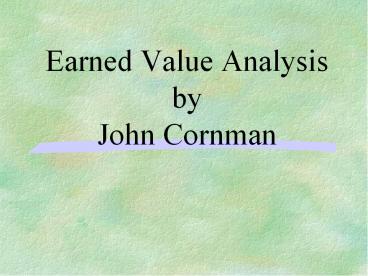Earned Value Analysis by John Cornman PowerPoint PPT Presentation
1 / 17
Title: Earned Value Analysis by John Cornman
1
Earned Value AnalysisbyJohn Cornman
2
Introduction
- Earned Value Analysis is an industry standard
way to measure a projects progress, forecast its
completion date and final cost, and provide
schedule and budget variances along the way. - Based on just 3 data points, it can provide
consistent, numerical indicators with which you
can evaluate and compare projects.
3
The 3 fundamental metrics
- Budgeted Cost of Work Performed.
- Budgeted Cost of Work Scheduled.
- Actual Cost of Work Performed.
4
Budgeted Cost of Work Performed
- This is the Earned Value.
- Abbreviated as BCWP.
- For completed work, it is the cost originally
budgeted to accomplish that work. - How much work was actually done?
5
Budgeted Cost of Work Scheduled
- Abbreviated BCWS.
- It is the total budgeted cost up to the analysis
date. - Approximated by the total budget multiplied by
the fraction of total project duration at the
analysis date. - How much work should have been done?
6
Actual Cost of Work Performed
- Abbreviated ACWP.
- What it actually cost to accomplish all the work
completed as of the analysis date. - What did the work that was actually done
actually cost?
7
Derived Metrics
- Schedule Variance (SV)
- Schedule Performance Index (SPI)
- Cost Variance (CV)
- Cost Performance Index (CPI)
8
A Few More Acronyms
- BAC - Budget At Completion
- Total Original Budgeted Cost
- Same as BCWS at completion
- EAC - Estimate At Completion
- Cumulative Actuals Estimate-To-Complete
- VAC - Variance At Completion
- Forecast of final cost variance
9
Doing The Math
- SV BCWP - BCWS
- Negative means Behind Schedule
- SPI BCWP / BCWS
- Less than 1.00 means Behind Schedule
- CV BCWP - ACWP
- Negative means Over Budget
- CPI BCWP / ACWP
- Less than 1.00 means Over Budget
- EAC BAC / CPI
10
An Example Lemonade
- Make 1,000 cups over 50 days
- Steady rate of 20 cups per day
- Budgeted cost per cup is 0.50
- Total project budget is 500
11
Lemonade Progress
- At end of day 10
- 150 cups have been made
- Total actual cost is 90 (ACWP)
12
Lemonade Status
- BCWS 100
- 10 days x 20 cups per day x .50/cup budget
- BCWP 75 (Earned Value)
- 150 cups x .50/cup budget
- SV BCWP - BCWS -25
- SPI BCWP / BCWS 0.75
- CV BCWP - ACWP 75 - 90 -15
- CPI BCWP / ACWP 0.833
13
Lemonade Forecast
- EAC BAC / CPI 500 / 0.833 600
- VAC BAC - EAC 500 - 600 100
(unfavorable) - Schedule at Completion 50 / SPI 50 / 0.75
66.67 days
14
MS Project 98 Support
15
Five Simple Criteria forEarned Value Applications
- 1. Define (scope) the project. . .with a WBS
- 2. Plan and schedule the project scope
- 3. Budget cost account plans to functions
- 4. Establish and maintain a performance baseline
- 5. Monitor performance and forecast final results
- Fleming Hoppleman. 1996. Earned Value
Management. PMI
16
(No Transcript)
17
Earned Value Management http//www.acq.osd.mil/pm
/

